Last Days - Movie Review
 Last Days 2005
Last Days 2005We have been racking our brains lately trying to remember if any other filmmaker has had such a late artistic breakthrough as the one Gus Van Sant is going through. Now, while we have always enjoyed his movies, well almost, we thought we had a grip on his style and temperament.
 Van Sant launched his singularly idiosyncratic career way back in 1985 with his shoestring ode to unrequited love – “Mala Noche.” It would take him a few years to produce his next major project, but when he did – it was more than worth it. The Indy sensation of 1989 – “Drugstore Cowboy” featured a career reviving performance by Matt Dillon and breakthrough turns by Kelly Lynch, James Le Gros and even that epitome of emptiness – Heather Graham. Copping several awards, including Best Screenplay honors from the New York and Los Angeles Critics’ Associations. He was on his way. “My Own Private Idaho” – 1991, has gained cult prominence over the years as the star vehicle for the late River Phoenix. Nicole Kidman had an early break with her uproariously vain turn in the wonderful “To Die For” in 1995.
Van Sant launched his singularly idiosyncratic career way back in 1985 with his shoestring ode to unrequited love – “Mala Noche.” It would take him a few years to produce his next major project, but when he did – it was more than worth it. The Indy sensation of 1989 – “Drugstore Cowboy” featured a career reviving performance by Matt Dillon and breakthrough turns by Kelly Lynch, James Le Gros and even that epitome of emptiness – Heather Graham. Copping several awards, including Best Screenplay honors from the New York and Los Angeles Critics’ Associations. He was on his way. “My Own Private Idaho” – 1991, has gained cult prominence over the years as the star vehicle for the late River Phoenix. Nicole Kidman had an early break with her uproariously vain turn in the wonderful “To Die For” in 1995.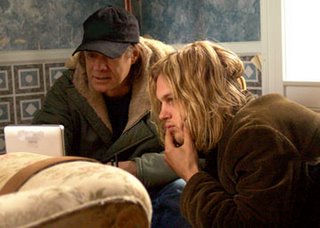 Gus won his (hopefully) first Oscar nomination with the box office smash “Good Will Hunting” – 1997, written by the then twinks, Matt Damon and Ben Affleck. His brief foray into Tinseltown territory also included the J.D. Salinger inspired “Finding Forrester” and the horrifically unnecessary scene-for-scene remake of Alfred Hitchcock’s “Psycho.” (What the fuck were you thinking, Gus?). While we enjoyed the direction on “Good Will Hunting” and “Finding Forrester”, we were getting a tad anxious for Gus to return to his Indy roots – for fear that he would forever be lost amidst the gloss. We didn’t have long to wait, and we never would have guessed the direction he finally took. Stripping down his films entirely, Gus Van Sant launched into his glorious second act phase of film directing by looking back to the works of such auteurs as Michelangelo Antonioni, Ingmar Bergman and a skootch of Bernardo Bertolucci. His work on “Gerry” starring Matt Damon and Casey Affleck, and his stunning accomplishment with “Elephant” practically declared war on his previous “major” productions. They were a revelation.
Gus won his (hopefully) first Oscar nomination with the box office smash “Good Will Hunting” – 1997, written by the then twinks, Matt Damon and Ben Affleck. His brief foray into Tinseltown territory also included the J.D. Salinger inspired “Finding Forrester” and the horrifically unnecessary scene-for-scene remake of Alfred Hitchcock’s “Psycho.” (What the fuck were you thinking, Gus?). While we enjoyed the direction on “Good Will Hunting” and “Finding Forrester”, we were getting a tad anxious for Gus to return to his Indy roots – for fear that he would forever be lost amidst the gloss. We didn’t have long to wait, and we never would have guessed the direction he finally took. Stripping down his films entirely, Gus Van Sant launched into his glorious second act phase of film directing by looking back to the works of such auteurs as Michelangelo Antonioni, Ingmar Bergman and a skootch of Bernardo Bertolucci. His work on “Gerry” starring Matt Damon and Casey Affleck, and his stunning accomplishment with “Elephant” practically declared war on his previous “major” productions. They were a revelation.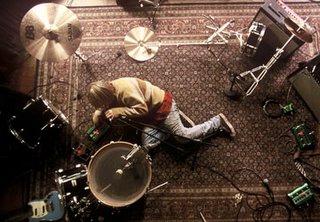 With “Last Days”, Gus Van Sant has expanded on his earlier work on “Gerry” and “Elephant” by maintaining the elegiac pacing and sparse dialog of his two previous films. We understand that this might be off-putting to many filmgoers who are looking for more, how we shall say it – idiotic, mundane, aimed at retards kind of filmmaking. Now we really don’t care which side of the “Film as Art / Film as Commerce” battle you fall on, we believe that film can border both sides. For every Hollywood style popcorn movie, there should always be the filmmaker that attempts a bit more. Not aiming at the gutter is a pretty good way to start out making a film. We hope that Gus Van Sant has learned his lesson with his foray into Hollywood territory. While he may be capable of pulling of the more popular flick, there is no reason he should not continue to grow as an artist and explore the kinds of film that inspired him in the beginning.
With “Last Days”, Gus Van Sant has expanded on his earlier work on “Gerry” and “Elephant” by maintaining the elegiac pacing and sparse dialog of his two previous films. We understand that this might be off-putting to many filmgoers who are looking for more, how we shall say it – idiotic, mundane, aimed at retards kind of filmmaking. Now we really don’t care which side of the “Film as Art / Film as Commerce” battle you fall on, we believe that film can border both sides. For every Hollywood style popcorn movie, there should always be the filmmaker that attempts a bit more. Not aiming at the gutter is a pretty good way to start out making a film. We hope that Gus Van Sant has learned his lesson with his foray into Hollywood territory. While he may be capable of pulling of the more popular flick, there is no reason he should not continue to grow as an artist and explore the kinds of film that inspired him in the beginning. While some may agree with Pauline Kael’s famous quote about Foreign Film Art House movies – she described them as the “Come Dressed as the Sick Soul of Europe” type of filmmaking. But did she? If you actually go back and read the original review you will note that she was speaking of those films that failed for her artistically. And let’s face it. She was a crotchety old bitch. She hated most everything. Then again, she adored Michelangelo Antonioni’s “L’Avventura” – as do we, and so clearly does Gus Van Sant. While that masterful classic explored a certain strata of society in their loneliness and eventual alienation from themselves, Gus Van Sant is more concerned with the emptiness found in the souls of today’s youth. With “Gerry” he painted a simple and quite literal descent into madness by trapping two young men in a desert landscape. With his Cannes Film Festival triumph – “Elephant” he explored the notorious present day school shootings from the point of view of a dispassionate outsider. And with “Last Days” he springboards off the last days of Grunge Rock’s Jesus figure – Kurt Cobain, and explores the mythology behind “the rock and roll cliché” of a drugged out and depressed star whose only escape is death.
While some may agree with Pauline Kael’s famous quote about Foreign Film Art House movies – she described them as the “Come Dressed as the Sick Soul of Europe” type of filmmaking. But did she? If you actually go back and read the original review you will note that she was speaking of those films that failed for her artistically. And let’s face it. She was a crotchety old bitch. She hated most everything. Then again, she adored Michelangelo Antonioni’s “L’Avventura” – as do we, and so clearly does Gus Van Sant. While that masterful classic explored a certain strata of society in their loneliness and eventual alienation from themselves, Gus Van Sant is more concerned with the emptiness found in the souls of today’s youth. With “Gerry” he painted a simple and quite literal descent into madness by trapping two young men in a desert landscape. With his Cannes Film Festival triumph – “Elephant” he explored the notorious present day school shootings from the point of view of a dispassionate outsider. And with “Last Days” he springboards off the last days of Grunge Rock’s Jesus figure – Kurt Cobain, and explores the mythology behind “the rock and roll cliché” of a drugged out and depressed star whose only escape is death.
Michael Pitt, who starred in our favorite film of last year, Bernardo Bertolucci’s “The Dreamers” is on hand to emulate Kurt Cobain’s final moments. This film isn’t really about the lead singer of Nirvana – it merely uses the truth of that situation as a backdrop for the legend he is creating. We have no idea if this film will stand the test of time, but for this year – it is clearly one of if not the best film.
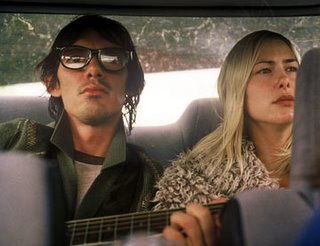 The setting is the wooded retreat that the rock star named Blake is holed up in, zonked out on drugs and surrounded by various peripheral hanger-ons, friends and sycophants. While they busy themselves with their mundane chores – Blake wanders thru the grounds oblivious to all around him and seemingly seeking an escape to his present predicament. His predicament, we might add – is hardly worth the drama. He is famous. A rock star, who appears to be the zeitgeist of his generation. He is also completely unable to connect with anybody around him. Except perhaps the Mormon boys who come calling on his doorstep, or the traveling Yellow Pages salesman who he encounters in one hilarious scene.
The setting is the wooded retreat that the rock star named Blake is holed up in, zonked out on drugs and surrounded by various peripheral hanger-ons, friends and sycophants. While they busy themselves with their mundane chores – Blake wanders thru the grounds oblivious to all around him and seemingly seeking an escape to his present predicament. His predicament, we might add – is hardly worth the drama. He is famous. A rock star, who appears to be the zeitgeist of his generation. He is also completely unable to connect with anybody around him. Except perhaps the Mormon boys who come calling on his doorstep, or the traveling Yellow Pages salesman who he encounters in one hilarious scene.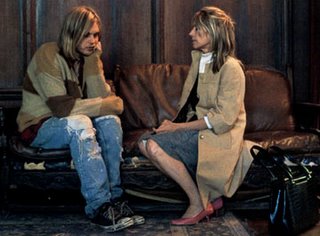 When the record executive, portrayed by Sonic Youth’s own Kim Gordon arrives to attempt one last intervention – he is so hopelessly far gone by that point, that her cutting words do little to assuage his pain.
When the record executive, portrayed by Sonic Youth’s own Kim Gordon arrives to attempt one last intervention – he is so hopelessly far gone by that point, that her cutting words do little to assuage his pain.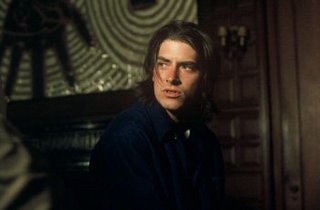 The hanger-ons and sycophants who surround and casually pretend to care for him, are more concerned with their own lives. While we wonder what has edged Blake into his slow descent of madness – we never question his feelings of loneliness or abandonment. This life is his and his alone to do with as he pleases. And for right now, he chooses to drink and consume drugs in sufficient quantity to dull the pain of the outside world.
The hanger-ons and sycophants who surround and casually pretend to care for him, are more concerned with their own lives. While we wonder what has edged Blake into his slow descent of madness – we never question his feelings of loneliness or abandonment. This life is his and his alone to do with as he pleases. And for right now, he chooses to drink and consume drugs in sufficient quantity to dull the pain of the outside world.  This meditation on the slow descent to death is riveting from the first scene. Gus Van Sant has taken his brilliant cinematographer Harris Savides, and slowly paints a portrait of a dying man, inches away from a possible salvation but too self consumed to notice. We don’t necessarily feel pity for him, but we understand that an artist’s life does not always contain sunshine, lollipops and rainbows. To be able to plunge in the very heart of creativity has always been to run the risk of releasing demons that will ultimately destroy you.
This meditation on the slow descent to death is riveting from the first scene. Gus Van Sant has taken his brilliant cinematographer Harris Savides, and slowly paints a portrait of a dying man, inches away from a possible salvation but too self consumed to notice. We don’t necessarily feel pity for him, but we understand that an artist’s life does not always contain sunshine, lollipops and rainbows. To be able to plunge in the very heart of creativity has always been to run the risk of releasing demons that will ultimately destroy you. What Gus Van Sant has done with creating the elegy of “Last Days” is to visualize the ultimate in selfish acts. A suicide may be appear to be the answer for many lost souls – but it merely opens the door to a myriad of questions from those who love them. He doesn’t romanticize the subject, nor look away from the deliriously macabre breakdown we are witnessing. What he does, is step aside enough for us to be able to judge the lead character in his final moments on this earth. Some may pity him, some revile him. It is the genius of Gus Van Sant with this truly wonderful film that we are allowed to peek into this sordid tale and emerged unscathed. A cautionary tale? Perhaps. We would like to see it as a meditation on stardom, and the painful toll it can take on one so fragile. And only a true artist like Gus Van Sant could pull off that hauntingly metaphysical ending! The hussy. A great film. Run out and see it! You’ll be glad we sent you. Bless you all!
What Gus Van Sant has done with creating the elegy of “Last Days” is to visualize the ultimate in selfish acts. A suicide may be appear to be the answer for many lost souls – but it merely opens the door to a myriad of questions from those who love them. He doesn’t romanticize the subject, nor look away from the deliriously macabre breakdown we are witnessing. What he does, is step aside enough for us to be able to judge the lead character in his final moments on this earth. Some may pity him, some revile him. It is the genius of Gus Van Sant with this truly wonderful film that we are allowed to peek into this sordid tale and emerged unscathed. A cautionary tale? Perhaps. We would like to see it as a meditation on stardom, and the painful toll it can take on one so fragile. And only a true artist like Gus Van Sant could pull off that hauntingly metaphysical ending! The hussy. A great film. Run out and see it! You’ll be glad we sent you. Bless you all!Written & Directed by Gus Van Sant
Starring
Michael Pitt as Blake
Scott Green as Scott
Lukas Haas as Luke
Asia Argento as Asia
Kim Gordon as Record Executive
Ricky Jay as Detective
Nicole Vicius as Nicole
Adam Friberg as Elder Friberg # 1
Andy Friberg as Elder Friberg # 2
Thadeus A. Thomas as Yellow Book Salesman
Harmony Korine as Guy in Club
Cinematography by Harris Savides
Film Editing by Gus Van Sant
Costume Design by Michelle Matland
Original Music by Rodrigo Lopresti
Art Direction by Tim Grimes

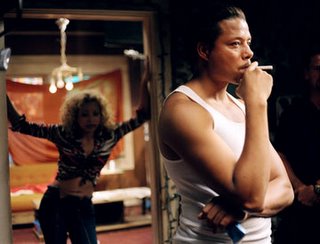 We would surely have still been impressed, if this was Mr. Howard’s debut. Comparing this performance with his work in “Crash”, makes it all the more fascinating and awe inspiring. His uptight
We would surely have still been impressed, if this was Mr. Howard’s debut. Comparing this performance with his work in “Crash”, makes it all the more fascinating and awe inspiring. His uptight 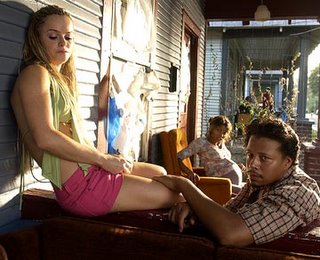 Set in the sweaty underbelly of a
Set in the sweaty underbelly of a 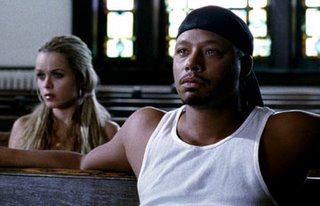 We were delighted by newcomer writer / director Craig Brewer’s sense of immediacy, locale, atmosphere and his delicious sense of humor. This man is also terrific in his casting and crew choices. Terrence Howard is truly a revelation in this lead role as the outwardly thuggish but emotionally poetic DJay.
We were delighted by newcomer writer / director Craig Brewer’s sense of immediacy, locale, atmosphere and his delicious sense of humor. This man is also terrific in his casting and crew choices. Terrence Howard is truly a revelation in this lead role as the outwardly thuggish but emotionally poetic DJay.  We had thought that
We had thought that 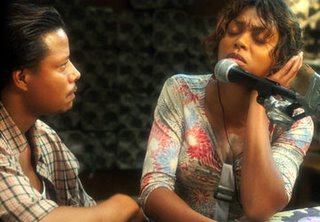 We have tremendous hope for future projects by writer / director Craig Brewer. His spare use of
We have tremendous hope for future projects by writer / director Craig Brewer. His spare use of 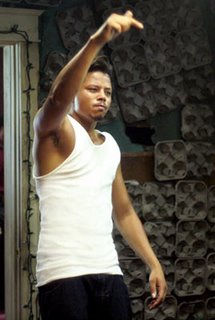 Written & Directed by Craig Brewer
Written & Directed by Craig Brewer
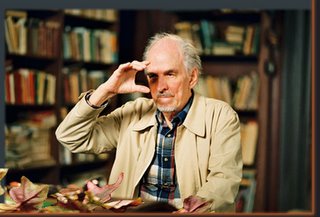 Way back in 1983, the legendary Swedish director
Way back in 1983, the legendary Swedish director  Turns out, he lied. Like most men. He's back. And with the arrival of his latest and quite possibly his very last film, “
Turns out, he lied. Like most men. He's back. And with the arrival of his latest and quite possibly his very last film, “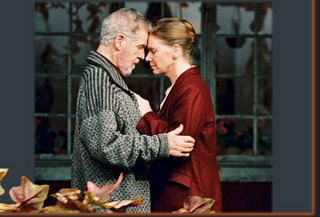 ”Saraband” picks up thirty some years after the events of “Scenes From a Marriage” with Marianne visiting her former husband Johan who lives in the Swedish countryside. She, like us is not aware of what she should expect upon arrival – she merely senses a desperate and complete need to see her former mate one last time. Upon her actual arrival, she is confronted with the disintegrating shell of a man who was once her lover. He may retain his intellect and panache, but suffers from the normal ailments befalling a man of his advanced age. He also suffers from a complete and vicious estrangement from his son, Henrik who is dealing with his own demons, attempting to mentor his talented musician daughter while both are still reeling from the death of Henrik’s wife.
”Saraband” picks up thirty some years after the events of “Scenes From a Marriage” with Marianne visiting her former husband Johan who lives in the Swedish countryside. She, like us is not aware of what she should expect upon arrival – she merely senses a desperate and complete need to see her former mate one last time. Upon her actual arrival, she is confronted with the disintegrating shell of a man who was once her lover. He may retain his intellect and panache, but suffers from the normal ailments befalling a man of his advanced age. He also suffers from a complete and vicious estrangement from his son, Henrik who is dealing with his own demons, attempting to mentor his talented musician daughter while both are still reeling from the death of Henrik’s wife. What occurs in the two hours it takes to unfold the drama of “Saraband” is the very stuff of grand filmmaking. Ingmar Bergman did not need to emerge from his cinematic retirement, his legend remained intact. But perhaps like similar giants of the cinema,
What occurs in the two hours it takes to unfold the drama of “Saraband” is the very stuff of grand filmmaking. Ingmar Bergman did not need to emerge from his cinematic retirement, his legend remained intact. But perhaps like similar giants of the cinema, 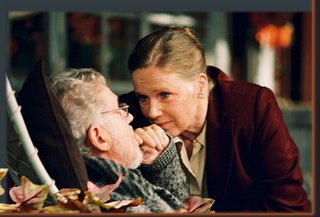 Liv Ullmann and Erland Josephson share their history with Bergman and with each other so effortlessly and grandly, it is truly like watching a master class in screen acting. The great thing about great actors as they enter their final season is their magical ability to bring forth emotional truths on the turn of a dime. There are no grand theatrics or hysterical scenes – merely quietly devastating scenes of raw emotion to be told. Watch the way Liv Ullmann quietly reenters her former husband’s life and becomes a sort of care giver, nursemaid, and confidante to Henrik’s daughter Karin. She understands she has no place as the mother figure, but her love for Johan compels her to linger in their lives long enough to attempt the near impossible – a potential reconciliation between father and son. Erland Josephson is simply brilliant as the old bear of a man who adamantly refuses to accept the blame for his sons faltering economic and emotional life.
Liv Ullmann and Erland Josephson share their history with Bergman and with each other so effortlessly and grandly, it is truly like watching a master class in screen acting. The great thing about great actors as they enter their final season is their magical ability to bring forth emotional truths on the turn of a dime. There are no grand theatrics or hysterical scenes – merely quietly devastating scenes of raw emotion to be told. Watch the way Liv Ullmann quietly reenters her former husband’s life and becomes a sort of care giver, nursemaid, and confidante to Henrik’s daughter Karin. She understands she has no place as the mother figure, but her love for Johan compels her to linger in their lives long enough to attempt the near impossible – a potential reconciliation between father and son. Erland Josephson is simply brilliant as the old bear of a man who adamantly refuses to accept the blame for his sons faltering economic and emotional life.
 We are not sure how this film would play on its own. We truly recommend you watch it in tandem with “Scenes From a Marriage.” Like similarly decades scattered sequels: “
We are not sure how this film would play on its own. We truly recommend you watch it in tandem with “Scenes From a Marriage.” Like similarly decades scattered sequels: “ While this film will surely be limited to
While this film will surely be limited to 
